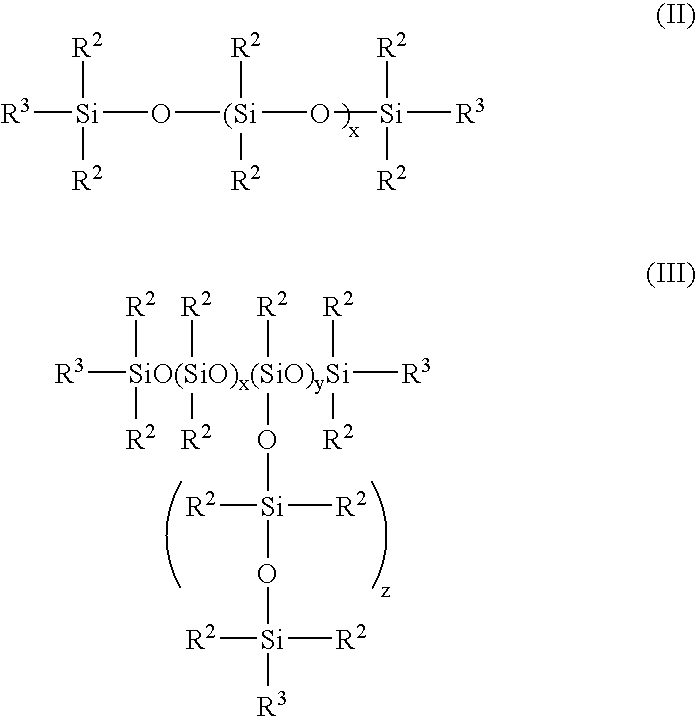Polyorganosiloxane micro-emulsion composition and raw material for cosmetics
- Summary
- Abstract
- Description
- Claims
- Application Information
AI Technical Summary
Benefits of technology
Problems solved by technology
Method used
Image
Examples
example 2
[0061] After dissolving 1 part of polyoxyethylene lauryl ether (25 EO) in 15 parts of ion exchange water, a mixture of 19.9 parts of octamethylcyclotetrasiloxane and 0.1 parts of methyltrimethoxysilane was added and premixed with the solution. A coarse emulsion with an average particle size of 0.25 .mu.m was obtained by passing the mixture twice through a homogenizer under a pressure of 350 kg / cm.sup.2. After mixing 9 parts of N-lauroylmethyltaurine sodium salt, 23 parts of ion exchange water, 6 parts of hydrochloric acid, and 3.5 parts of polyoxyethylene lauryl ether (25 EO) in a separate container, the mixture was maintained at 70.degree. C. Next, the above-described coarse emulsion was added to this mixture under agitation in a dropwise manner over a period of 2 hours and the resultant mixture was maintained for 8 hours at 70.degree. C. The mixture was cooled to 25.degree. C. and maintained at this temperature for another 10 hours. After that, a polydimethylsiloxane micro-emulsio...
example 3
[0062] After dissolving 1 part of polyoxyethylene lauryl ether (25 EO) in 15 parts of ion exchange water, a mixture of 19.95 parts of octamethylcyclotetrasiloxane and 0.05 parts of hexamethyldisiloxane were added and premixed with the solution. A coarse emulsion with an average particle size of 0.25 .mu.m was obtained by passing the mixture twice through a homogenizer under a pressure of 350 kg / cm.sup.2. After mixing 9 parts of N-lauroylmethyltaurine sodium salt, 23 parts of ion exchange water, 6 parts of hydrochloric acid, and 3.5 parts of polyoxyethylene lauryl ether (25 EO) in a separate container, the mixture was maintained at 70.degree. C. Next, the above-described coarse emulsion was added to this mixture under agitation in a dropwise manner over a period of 2 hours and the resultant mixture was maintained for 8 hours at 70.degree. C. The mixture was cooled to 55.degree. C. and maintained at this temperature for another 10 hours. After that, a polydimethylsiloxane micro-emulsi...
example 4
[0063] After mixing 9 parts of N-lauroylmethyltaurine sodium salt, 38 parts of ion exchange water, 6 parts of hydrochloric acid, and 4.5 parts of polyoxyethylene lauryl ether (25 EO), the mixture was maintained at 70.degree. C. Next, 20 parts of octamethylcyclotetrasiloxane were added to this mixture under agitation in a dropwise manner over a period of 2 hours and the resultant mixture was maintained for 8 hours at 70.degree. C. The mixture was cooled to 25.degree. C. and maintained at this temperature for another 10 hours. After that, a polydimethylsiloxane micro-emulsion (Sample A-4) was obtained by terminating the polymerization reaction by adding a 10% aqueous solution of sodium hydroxide to the mixture in a dropwise manner until the pH of the reaction solution became close to 7. The external appearance and physical properties of the resultant micro-emulsion are listed in Table 2.
PUM
| Property | Measurement | Unit |
|---|---|---|
| Percent by mass | aaaaa | aaaaa |
| Percent by mass | aaaaa | aaaaa |
| Percent by mass | aaaaa | aaaaa |
Abstract
Description
Claims
Application Information
 Login to View More
Login to View More - R&D
- Intellectual Property
- Life Sciences
- Materials
- Tech Scout
- Unparalleled Data Quality
- Higher Quality Content
- 60% Fewer Hallucinations
Browse by: Latest US Patents, China's latest patents, Technical Efficacy Thesaurus, Application Domain, Technology Topic, Popular Technical Reports.
© 2025 PatSnap. All rights reserved.Legal|Privacy policy|Modern Slavery Act Transparency Statement|Sitemap|About US| Contact US: help@patsnap.com


